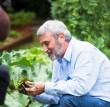One of the world’s most specialised careers would have to be chicken sexing.
Melbourne man, Bob Martin, has spent sixty years studying and practising vent-sexing. His book, The Specialist Chicken Sexer is a fascinating documentation of this obscure but vital quest for technical accuracy.
His book explains how poultry owners once waited until chicks were five to six weeks old before differentiating male from female. This became visible when adult feathers started appearing and cockerels (males) developed different feathers from pullets (hens). But for commercial egg producers it’s important to keep the females and not feed males unnecessarily.
In 1924 three Japanese scientists developed a technique for determining the sex of hatchlings investigating the chick’s vent (rear end). In 1934 the first Japanese chicken sexers arrived in Australia to train locals in the new technique. Some Australians were trained but World War II intervened and the Japanese chicken sexers went home.
Mr Martin’s book describes the technique which involves close examination of the chicken’s cloaca, which is a common external opening for the digestive, urinary and reproductive tract. The sexer looks for a degenerate penis which marks all males but also 15% females. The skill comes in determining the sex of this 15%. It sounds simple, but in fact requires great concentration, accuracy, long hours of training and practice examination.
Our segment featured two top chicken sexers, Mr Harley Hall, one of the original chicken sexers trained by the Japanese in the early 1930s, and Mr Frank Evans, considered one of Australia’s all-time top sexers, and able to sex 800 chicks an hour with 99% accuracy.
The value to the industry and the skill required is recognised and Mr Martin said top sexers may earn $400-$700 a day plus expenses. A fair day’s work could see 5000-7000 chicks sexed.
Further information
The Specialist Chicken Sexer is also a record of the importance the discovery made to the poultry industry worldwide, as well as accounts of Australian chicken sexers abroad post-World War II. It is available from Bernal Publishing, 4 Frank Street, Boxhill South, VIC, 3128 and costs $20 including postage and handling. For more information contact Mr Bob Martin, phone (03) 9808 3775.



